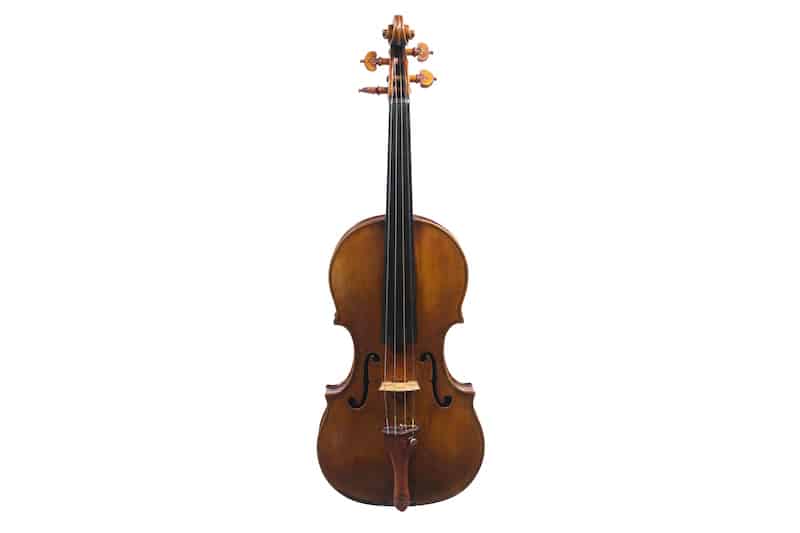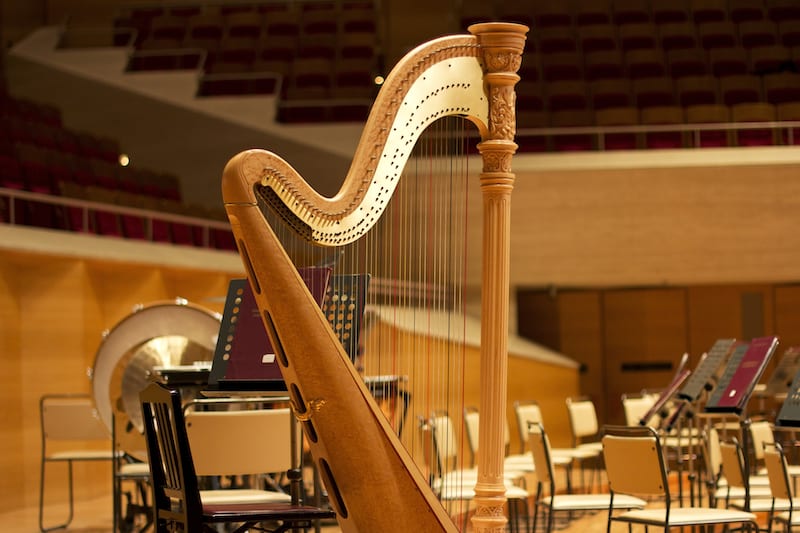A modern symphony orchestra has a lot of instruments in it, with some of the largest having over 100 musicians!
The string section is one of the most important families in an orchestra and is important for carrying the melody. It is also usually the largest group of instruments in an orchestra.
You probably already know about the violin, but which other string instruments are there, and what’s their role?
Well, in this post, we’re going to take a look at the other common (and not-so-common) string instruments that you might see in an orchestra. Let’s get started.
1. Violin

The highest-pitched member of the string family and used extensively in both Western classical and folk music, the Violin has a long history, dating back to the 16th century when it first appeared in Italy.
Since then, it has become one of the most popular musical instruments in the world and is an essential instrument in orchestras around the globe.
The violin is played by holding it under the chin and using a bow to draw the strings across the instrument’s body. The left hand presses down on the strings to change their pitch, while the right hand controls the bow.
Due to it being the highest-pitched string instrument, it often plays the melody. But, in addition to its melodic role, the violin also plays an important part in orchestral texture, often providing harmonic support for other instruments.
As a result, it is one of the most versatile and essential instruments in any orchestra.
2. Viola

Next, we have the Viola, which is a string instrument that looks almost identical to the violin. However, it is slightly larger and has a lower, deeper, mellow sound because its strings are tuned to a lower pitch.
In an orchestra, the viola often plays the harmony parts, filling in the gaps between the higher-pitched instruments. The instrument has a wide range of dynamics and expressiveness, making it an essential part of any orchestral ensemble.
In recent years, the viola has gained popularity as a solo instrument, with many concertos and recitals being written specifically for the instrument.
If you’re looking to add some depth and richness to your musical repertoire, be sure to give the viola a try.
3. Cello

Next, we have the Cello, which is a bowed string instrument with a deep, rich sound. They have four strings, which are tuned to the pitches C, G, D, and A.
Unlike the violin and viola, the cello is played sitting down, and the player holds the instrument between their legs.
Today, the cello is a staple of Western classical music, and it can be heard in everything from symphonies to solo pieces.
The cello has a wide range of tones and dynamics, making it one of the most versatile and essential instruments in the orchestra.
4. Double Bass

The fourth instrument we’ll look at is the Double Bass, which is also known as the Contrabass, Upright Bass, or String Bass. It has four strings that are tuned to the pitches E, A, D, and G.
It’s the largest string instrument in the orchestra, and it also has the lowest pitch! Because of its size, the players often have to stand to be able to play it, although sometimes they’ll also sit on a high stall.
Its name comes from the fact that its role was originally to double the bass line or music. Like the other stringed instruments above, the double bass is also played with a bow but can also be plucked, which is called pizzicato.
Its role in orchestras nowadays is to provide the foundation for the rest of the orchestra and, as such, is an essential part of any symphony orchestra.
5. Piano

Here, we have to take a break from exploring string instruments in an orchestra because, strictly speaking, the Piano is a percussion instrument.
You might think, “But wait, the piano has strings inside. Surely it’s considered a type of string instrument?”
And while that’s true, it’s the way that the strings are played that makes it a percussion instrument. That’s because the strings inside are hit by hammers when you press down one of the keys.
They have a huge range both dynamically — their powerful sound can fill a large concert hall — and also in terms of pitch, from deep bass notes to high treble notes, giving composers a lot to work with when writing for it.
While pianos aren’t a staple instrument of orchestras, due to their popularity around the world, a lot of concertos and symphonies have been written to feature them.
They typically play a supporting role, providing chords and accompaniment for other instruments. However, the piano can also take center stage, with many famous concertos and solo pieces featuring this versatile instrument.
6. Harp

Unlike the piano, the Harp is undeniably a string instrument in the orchestra.
With a rich history dating back to ancient Egypt and Greece, there have been many types of harps in lots of different cultures around the world.
While the modern harp that you’ll see in orchestras typically has 47 strings, historical harps have as few as 11 strings. The musicians play it by plucking the strings with their fingers. The shorter the string, the higher the pitch.
But modern harps are incredibly difficult as not only does the harpist have to worry about the 47 strings but also a series of pedals at the base of the instrument, which puts it into different keys!
The harp is a versatile instrument that can be used in a wide range of genres, from classical to pop. In an orchestra, the harp typically plays a supportive role, providing a light and airy sound.
However, the instrument can also be featured in solo pieces, such as Debussy’s “Clair de Lune” or Handel’s “The Arrival of the Queen of Sheba.”
Regardless of its role, the harp is a beloved member of the orchestra, and its unique sound is sure to delight audiences of all ages.
7. Guitar

You don’t often see a Guitar in an orchestra, but occasionally, you will when the piece is a guitar concerto.
With six strings tuned to the pitches E, A, D, G, B, and E, the guitarist plucks the strings with one hand while pressing down on the fretboard to change the pitch with the other.
But this isn’t the same type of guitar you’ll see at rock concert arenas. You’ll only find a special type of acoustic called a classical guitar. These use nylon strings and have a different body shape from their steel-stringed cousins.
There isn’t a huge amount of orchestral music written for the guitar. Still, you’ll find a lot of Spanish-influenced classical music that features it, with the guitarist John Williams probably being the most well-known performer.
Summing Up Our List Of Orchestra String Instruments
As you can see, there are many different types of string instruments that can be found in an orchestra. They’re an essential part of the orchestra, and without them, classical music would not be the same.
Each instrument has its own unique sound, and when played together with the other instruments in an orchestra, they create a beautiful harmony.
If you’re curious to know about other instruments in an orchestra or any type of music group, you can browse through our collection of articles at Hello Music Theory. We hope you have learned something new and useful from this article!

